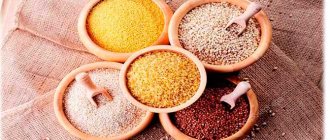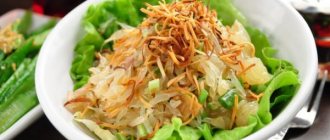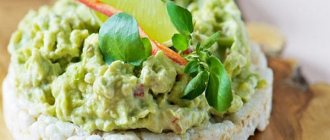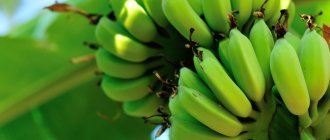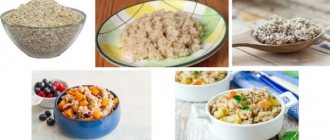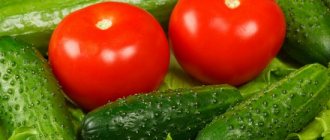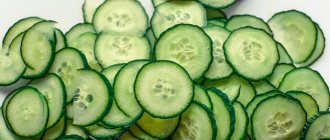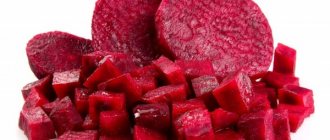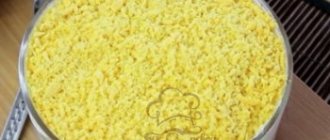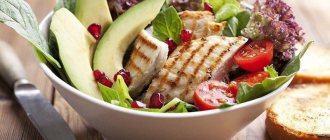The versatility of the product is an advantage among chefs and ordinary housewives. The extravagance of Japanese cuisine has conquered more than one continent, precisely thanks to various, not quite ordinary ingredients. Chuka algae, also known as hiyashi wakame, are especially popular among the residents of the Rising Sun. When they are added to various recipes, you can get a real culinary masterpiece.
Do you eat seaweed?
- Yes 89%, 617 votes
617 votes 89%617 votes - 89% of all votes
- No 11%, 77 votes
77 votes 11%
77 votes - 11% of all votes
Total votes: 694
24.09.2019
- Yes 89%, 617 votes
617 votes 89%617 votes - 89% of all votes
- No 11%, 77 votes
77 votes 11%
77 votes - 11% of all votes
Total votes: 694
24.09.2019
×
You or from your IP have already voted.
Chuka algae, what is it?
Wakame algae is associated with Japan, but the name "chuka" means "Chinese" in Japanese. It was from the Celestial Empire that they were initially imported to Japan in large quantities.
Thanks to their neutral taste and subtle, subtle smell of the sea, they are added to salads, rolls, noodles and much more. This is not surprising, because the Japanese are rightfully considered long-livers due to their diet and variety of dishes rich in various nutrients.
Foreigners often confuse wakame with seaweed - kelp due to their external similarity. However, both products have distinctive features in their composition and calorie content. Chukas have a more delicate texture and a rich iodine smell. You can see how they look in the photo.
Harm, contraindications
Chuka salad, the beneficial properties of which are actively advertised, in some cases may not be recommended or even contraindicated. When adding it to your diet, be aware that excessive iodine intake can cause thyroid dysfunction. Since this mineral is contained in large quantities in the product, it is possible to obtain too high a dosage, especially with prolonged daily consumption of large portions. Symptoms such as weight gain or swelling may occur as a result of the condition.
Anyone taking medication for thyroid disease should talk to their doctor before adding seaweed to their diet.
Other possible harm is associated with heavy metals. Algae absorb minerals and nutrients from the sea. If the water contains heavy metals, wakame will also absorb them. Most studies confirm that edible seaweeds tend to have very low levels of toxic metals (aluminium, cadmium and lead). However, these harmful substances can accumulate over time in the body of a person who eats this product every day. Therefore, it is necessary to pay attention to what source the algae comes from.
Beneficial features
The beneficial properties of chuka algae are due to the presence of many microelements. Their iodine content is especially pronounced. Regular consumption of wakame fully satisfies the daily replenishment of nutrients in the body for dieters and vegetarians. They:
- Improves the functioning of the heart and cardiovascular system;
- Helps strengthen blood vessels;
- Remove toxins and waste from the body, cleansing the liver and intestines;
- Normalize the functioning of the gastrointestinal tract;
- Effectively cope with constipation and diarrhea;
- Reduces bad cholesterol levels;
- Optimize thyroid function;
- Helps improve vision and hearing;
- They should be consumed as food for psoriasis;
- Due to their rich chemical composition, they promote skin rejuvenation.
An additional benefit of the product is to improve brain function.
The benefits of algae can be highlighted separately for men in the form of increased production of testosterone and sperm. In women, they help improve the functioning of the reproductive system and tone the muscles. Do you eat seaweed?
- Yes 89%, 617 votes
617 votes 89%617 votes - 89% of all votes
- No 11%, 77 votes
77 votes 11%
77 votes - 11% of all votes
Total votes: 694
24.09.2019
- Yes 89%, 617 votes
617 votes 89%617 votes - 89% of all votes
- No 11%, 77 votes
77 votes 11%
77 votes - 11% of all votes
Total votes: 694
24.09.2019
×
You or from your IP have already voted.
The use of wakame is especially important for people with an increased risk of developing cancer. The girls appreciated the beneficial cosmetic effects of algae. They are used to make masks for the face and hair. The latter, after such care, become thicker and shinier. The composition of the product helps restore sleep, eliminates neuroses and other worries.
Information: Chuka algae is a powerful aphrodisiac that increases male and female libido.
Chuka algae is beneficial, but can cause harm. They are not recommended for use in the first and last trimesters of pregnancy. In the first trimester, cases of heartburn are common; in recent months, it can cause premature contractions.
Harm can also occur during breastfeeding. The high iodine content in the plant leads to hormonal changes in the baby and causes allergies. For the same reasons, children under 12 years of age are prohibited from consuming wakame. After crossing this milestone, this product only brings benefits.
Where did the overseas guest come to us from?
In general, Wakame is the name of a brown wild algae that grows on underwater rocks along sea coasts. The Japanese appreciated it for its soft and pleasant taste and satiety with zero calorie content. Chuka is a common ingredient in many Japanese dishes.
It is added to sushi and rolls, eaten as a salad alone or with additives, and made into noodles. The product arrives in our stores frozen. The benefits of a quick-frozen sea plant remain almost the same as those of a fresh product.
Sometimes you can find ready-made salad with preservatives and seasonings, sold by weight or in sealed packages.
Chemical composition and calorie content
Full saturation of the body with all useful elements is an undeniable advantage of the product. It contains natural collagen, vegetable protein, amino acids, fiber:
- Minerals: iodine, iron, magnesium, manganese, copper, zinc, calcium, selenium, phosphorus, potassium. All these minerals strengthen the cardiovascular, digestive and respiratory systems;
- The vitamin complex consists of B vitamins (choline, thiamine), A, C, D, K, E. They improve the condition of the skin, hair, nail plates and have a beneficial effect on the body;
- Thanks to amino acids, regular consumption of wakame leads to weight loss without loss of muscle tone. They are optimal for restoring the body after physical and psychological stress;
- Antioxidants remove free radicals, preventing the development of cancer cells. Reduce the risk of strokes, atherosclerosis, rheumatoid arthritis, diabetes;
- Plant protein is necessary to increase the elasticity of the skin, muscle tissue, and strengthen bones;
- Fiber acts as a cleansing “brush”, removing toxins and waste from the body;
- Fatty acids (Omega-3) fight signs of aging, remove “bad” cholesterol and promote active brain activity.
In addition to its beneficial properties, chuka seaweed is a low-calorie product, which is important for women on a diet. 100 grams of product contains from 60 to 63 kilocalories. Depending on the subspecies, they contain about 70 percent carbohydrates, 28 percent bacon and only 5 percent fat.
Dishes
Chuka is used in home cooking mainly in the preparation of salads - in a variety of combinations and with a variety of dressings. Also, this seafood is sometimes added to sushi and rolls to give them a delicate taste, increase beneficial properties and reduce calorie content. It goes well with stewed vegetables, boiled beans, fresh tomatoes and cucumbers, eggs and scrambled eggs, seafood and chicken breast. It’s easy to experiment with the composition and come up with your own variations based on the recipes below.
Salatov
In Japan, the name “Chuka” combines a lot of different salad options, the common feature of which is the presence of wakame, thinly sliced vegetables (cucumbers, carrots), often funchose, sometimes meat or ham, seeds and sesame oil, as well as a light dressing - soy, nut or sesame. The sauce is considered the most important addition to various Asian dishes. Its various varieties are sold in stores and can be easily prepared at home. It should be borne in mind that it is precisely when such a seasoning is introduced into “Chuka” that the calorie content of the finished dish can increase significantly. Thus, the traditional dressing for such a snack is considered to be nut sauce, for the preparation of which nuts are ground in a blender with vegetable oil, lemon juice and other flavorings (according to the recipe). Accordingly, the presence of such nutritional components provides a fairly high calorie content both for the resulting dressing and for the entire dish as a whole.
Classical
The classic recipe for this snack is the simplest of all and the taste is as close as possible to the one consumed by the inhabitants of Japan. Taking into account the preliminary defrosting of the main component, the cooking procedure will take about 15 minutes. In addition, this recipe is better than all others for a diet during a period of weight loss, since the calorie content of Chuka in this version is very low and amounts to only 90 kcal per 100 grams. This figure can be reduced to 60 kcal/100 g if you reduce the amount of sesame seeds indicated in the ingredients by half.
Before cooking, first defrost 250 g of seaweed. Lightly fry 2 tbsp. l. sesame seeds. Chop 100 g of pickled Japanese kikurage mushrooms. Dilute ½ tbsp in 50 ml of water. l. starch. Mix all the recipe ingredients, add 50 ml of soy sauce, 1 tsp. freshly squeezed lemon juice, 1 tsp. sesame oil. Mix carefully. If desired, spice up the dish by seasoning with thin rings of hot chili pepper.
With squid
Chuka salad with seafood is a real iodine fortified concentrate. The ingredients include squid, but they can easily be replaced with shrimp or crab sticks. It should be borne in mind that the calorie content of Chuka stated in the recipe of 122 kcal/100 g will be reduced to 95 kcal/100 g, which will make the snack less exotic, but more suitable for the diet menu.
First, prepare 250 g of algae (defrost or pour in dry ones to swell). Fry 2 tbsp. l. sesame seeds. Boil 2 squid carcasses in salted water, cool slightly and cut into thin strips, pour in a mixture of 2 tsp. sesame oil and 3 tbsp. l. soy sauce. Mix all ingredients, reserving half the toasted sesame seeds. Place in a salad bowl, sprinkle with the remaining seeds, decorate with quail eggs, boil 4 of them and cut them into halves.
With nut sauce
Peanut sauce is a traditional condiment for Japanese seafood appetizers. In this case, it is prepared from roasted sesame seeds, 100 grams of which contain 565 kcal, with the addition of peanuts and walnuts, respectively 567 kcal and 654 kcal per 100 g. Therefore, the calorie content of Chuka with this addition increases almost 2 times - to 188 kcal/100 g, while the dish greatly benefits in taste, since the original nutty aroma favorably sets off the neutral taste of algae.
Before cooking, bring 250 g of wakame to readiness (defrost or soak in water to swell). Fry 2 tbsp in a dry frying pan. l. sesame seeds and a handful of peanut-walnut mixture. Combine the toasted seeds and nuts and grind them with a blender, add 4 tbsp. l. soy sauce, 2 tsp. sesame oil, 1 tbsp. l. rice, apple or wine vinegar and 3 tbsp. l. cold water. Mix again with a blender. If the consistency is too thick, dilute with a small amount of water. Season the seaweed with sauce and leave for 1 hour to marinate.
Another traditional option for preparing nut sauce involves adding starch to the composition. For this, 1 tsp. starch diluted in 3 tbsp. l. water, mix 50 ml of water and soy sauce separately, heat to a boil and gradually pour in the diluted starch. The thickened mass is left to cool, and then mixed with the remaining ingredients according to the recipe. With the introduction of such an additive, the number of calories in the snack will increase to 190 kcal/100 g.
With vegetables
When you combine seaweed with vegetables, you get a savory, vitamin-rich snack that can also be prepared in a matter of minutes. The addition of bell pepper, carrots and celery allows you to reduce the calorie content of Chuka to 60 kcal/100 g and at the same time significantly increase the nutritional value.
To prepare, first fry 1 tbsp. l. sesame until golden brown. Pour into a bowl, add 1 tsp. olive and sesame oil, 2 tbsp. l. soy sauce, 1 tbsp. l. apple cider vinegar and 2 tsp. liquid honey. Stir, add 1 tsp. grated ginger root, lemon zest and lemon juice.
Wash, peel and cut into thin strips or grate 2 cucumbers, 1 bell pepper and 1 carrot on a “Korean” grater. Combine the vegetable “mix” with 100 g of ready-made (thawed or soaked in water) wakame, pour over the sauce. Before serving, garnish with lemon slices.
With kelp
This version of the appetizer combines wakame and seaweed, but otherwise sticks to the classic recipe. This approach can significantly reduce the cost, but at the same time slightly increases the total calorie content of Chuka - up to 92 kcal/100 g (due to the fact that kelp contains 49 kcal/100 g versus 45 kcal in vakama).
Chop 1 onion into thin half rings and scald with boiling water. Cut 100 g of pickled kikurage mushrooms into small strips. Connect all components. Separately prepare the dressing by mixing 2 tbsp. l. toasted sesame seeds, 1 tbsp. l. vegetable oil and apple cider vinegar, 1 tsp each. salt and sugar. Add to the seaweed-vegetable mixture and garnish with lemon and herbs.
Green from superfoods
Green superfood cuts are an exceptional nutritional option for people who lead a healthy lifestyle, follow the principles of proper nutrition and watch their weight. Thanks to green vegetables and chuka, the calorie content of this dish is 97 kcal/100 g, and the nutritional value significantly exceeds the energy value.
Tear 75 g of lettuce leaves into small pieces with your hands, cut ½ avocado and ½ English cucumber into small pieces. Mix all ingredients, add 75 g wakame and 1 tbsp. l. sesame Squeeze juice from half a lemon on top. To make the dressing, puree the remaining half of the avocado, 1 clove of garlic and 3 sprigs of cilantro in a blender. Pour in 1 tbsp. l. vegetable oil, ½ tsp. apple cider vinegar and a pinch of salt, mix again with a blender. Place the seaweed-vegetable mixture on a plate and pour the dressing on top.
Warm with beef
To prepare a warm appetizer, use any “Chuka” salad, which is bought in a store or prepared according to one of the above recipes. The main additional component is 150 g of beef, which is cut into thin strips and fried in a frying pan with the addition of a small amount of vegetable oil without spices and salt. Pour 2 tbsp into the fried meat. l. soy sauce and leave for 10 minutes to marinate. At this time, chop 1 bell pepper into strips and also fry over high heat. Mix everything, add 150 g of seaweed salad and sprinkle with a pinch of sesame seeds.
When using the classic “Chuki” described above as part of a dish, the calorie content of the warm snack as a whole will increase to 190 kcal per 100 grams. In the case of using other preparation options or a purchased salad, 100 kcal contained in 100 grams of meat additive is added to its energy value.
Rolls
Rolls made from two different seaweeds, one of which serves as a shell, and the second is part of the filling, look very beautiful, have an extraordinary taste and double benefits for human health. The cost of such a snack is quite high, and the calorie content is 173 kcal/100 g, so it is recommended to eat it only on holidays.
Cooking begins by boiling rice. To do this, take 200 g of special rice grains for sushi and cook according to the instructions on the package. Cool the boiled rice slightly, and then add 20 ml of rice vinegar and mix thoroughly with a wooden spoon or spatula.
Cut the filling components: 60 g salmon or salmon and 8 king prawns into thin slices, 30 g cucumber into narrow slices. Thaw 40 g of wakame. This amount of food should be enough for 2 sheets of nori.
The bamboo mat is completely wrapped in cling film and a sheet of nori is laid out on it. Distribute the rice filling evenly over the surface, leaving 2 cm free on one (far) edge.
A strip of half of the prepared filling is laid out in the middle of the rice layer - first salmon, next to it - shrimp, then seaweed ribbons and cucumbers. Slowly, carefully roll the roll using a mat. Lightly press on all sides, giving the product a square shape. Cut into 6 rolls. The second half of the products is prepared in the same way.
Hot dog with crabs
To prepare one hot dog, prepare the filling from 15 g of crab meat and 50 g of tiger shrimp, which are crushed using a blender or meat grinder, and then add 5 g of cream and 1 egg. Mix thoroughly, form a sausage, and grill. At this time, chop 15 g of Chinese cabbage, add 15 g of seaweed and boiled funchose, and pour in 5 ml of sesame oil.
The hot dog bun is cut slightly and warmed up. A fried sausage is placed inside, then cabbage and seaweed slices are laid out, topped with spicy sauce, and decorated with slices of hot chili pepper, sesame seeds and cilantro. When using all these ingredients, you get a hearty hot dog with the addition of chuka with a calorie value of 734 kcal/100 g.
Shrimp burger
To prepare burgers with shrimp according to this recipe, use the classic “Chuka” salad with a calorie content of 90 kcal/100 g. Although the total energy value of the finished sandwich does not decrease from this and turns out to be very high - about 640 calories per 100 g.
To prepare, take 4 buns with sesame seeds, cut in half and grill on both sides. 8 tiger shrimps are cleaned and also fried, but in spices - Svan salt and curry. Mix 100 g of seaweed salad with ginger sauce to taste. Peel 1 avocado and cut into thin slices. First put arugula on the lower halves of the fried buns, on top - avocado slices, on them - 2 shrimp, then - a seaweed-ginger mixture and all this is covered with the upper halves of the buns.
Rating of food delivery for weight loss
Delivery of food with calculated calorie content, ready-made diets. No more cooking and counting calories!
Go
Go
Selection and storage
Seaweed grows at a depth of no more than 100 meters, but for storage and subsequent transportation it is frozen or dried. Less commonly, the plant is canned or pickled. It is in this form that the product can be purchased at retail or wholesale. There are several factors to consider when purchasing:
- It is better to buy a frozen plant in transparent packaging.
- Best before date. Frozen seaweed is stored for a maximum of one year, dried - no more than two years.
- Ice should not be present in a package containing a frozen product. This factor indicates repeated freezing and thawing of the product, which does not have the best effect on its quality.
- The natural color of the product is light green, a shade of malachite (you can see it in the photo).
- Their taste is soft and delicate and does not have a rough tint, like seaweed.
- The predominant aroma is marine with a less pronounced odor of iodine.
For consumption, it is better to give preference to frozen or dried products. The latter are pre-soaked before cooking.
Recommendations for eating
There are no restrictions on the amount of wakame consumed, but you should still eat them in moderation so as not to provoke hormonal imbalance.
If you have never eaten them before, start with 20-40 grams.
Before use, the seaweed is thawed . The salad can be eaten as a separate appetizer or used in preparing various dishes.
Seaweed can also be pickled or dried - in both forms they are equally useful.
Culinary tricks
Salads based on chuka seaweed are loved all over the world for their delicate, fresh taste and juicy color that awakens the appetite. Chukas do not smell as strongly of iodine as the kelp we are used to.
They go well with vegetables, noodles, seafood, chicken and nuts. Neutral in taste, dishes made from chuka seaweed require bright, spicy sauces. The simplest of them is based on soy sauce:
Required:
- 0.5 cup soy sauce
- 0.5 glasses of water
- 2 teaspoons starch
- 2 teaspoons lemon juice
- 2 teaspoons sesame oil
Mix the ingredients in a saucepan, put on fire, thicken the sauce without bringing to a boil, remove and pour over the prepared (thawed and scalded with boiling water) seaweed. Sprinkle sesame seeds on top.
Nutritional value of the product per 100 g:
Proteins - 7 g
Fats - 1 g
Carbohydrates - 17 g
Energy value per 100 g is about 60 kcal.
Those who carefully monitor the amount of calories should keep in mind that only the chuka seaweed itself is non-caloric, and the sauce contains quite a lot of calories.
